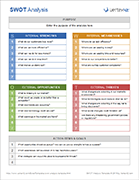Pros and Cons List
Creating a Pros and Cons List can be a useful way to help you analyze a decision. This tool is used mainly when you have a "whether or not" type decision, such as whether to accept a new job in a different city. I have used a pros and cons list on many different occasions (such as when I decided to completely change careers). Instead of just a list, I like to rate the value or importance of each item, so that is how I set up this template. In addition to listing the pros and cons, you can enter a value between 0-10 to indicate how important each factor may be.
Although a pros and cons list might only help justify a decision you have already made, it does provide an organized way to get your thoughts down on paper. That process alone can be a stress reliever for some people. You can also have someone else review your list to offer a second opinion, because sometimes we may be too emotionally involved to make an objective decision on our own. For example, a friend might help you realize that Item A may not be quite as important as you think it is.
Pros and Cons List
for Excel or Google SheetsDownload
⤓ ExcelLicense: Private Use (not for distribution or resale)
"No installation, no macros - just a simple spreadsheet" - by Jon Wittwer
Description
This pros and cons list template helps you analyze and compare each of the items in your list. The point of this exercise is to recognize that some things you list in the pros and cons don't matter very much, while others may be extremely important to you.
In the Value columns you enter a number on a scale between 0 and 10 to indicate the weight or importance of each factor (10 being the highest importance). The spreadsheet uses conditional formatting to display in-cell data bars, making it easy to visually compare the different factors. You can create what is called a "Tornado Chart" by sorting the table by Value, from highest to lowest.
The rating scale is pretty basic, and is not meant to be over-analyzed. The score at the top is just a sum of the individual ratings. The point isn't to make a decision based solely on the score at the top. The process of creating and analyzing the list is the objective. Many people do this type of exercise and end up making a decision based on their gut, inspiration, or need ... regardless of the score. That is why you don't need to make the rating and the score overly complicated.
References and Resources
- Pros and Cons of Moving at blog.upack.com - Some things to consider when you are thinking about moving.
- The Pros and Cons of Pros and Cons Lists at hbr.org - This is a great article that talks about why a pros and cons list may not always be the best method for decision-making.



